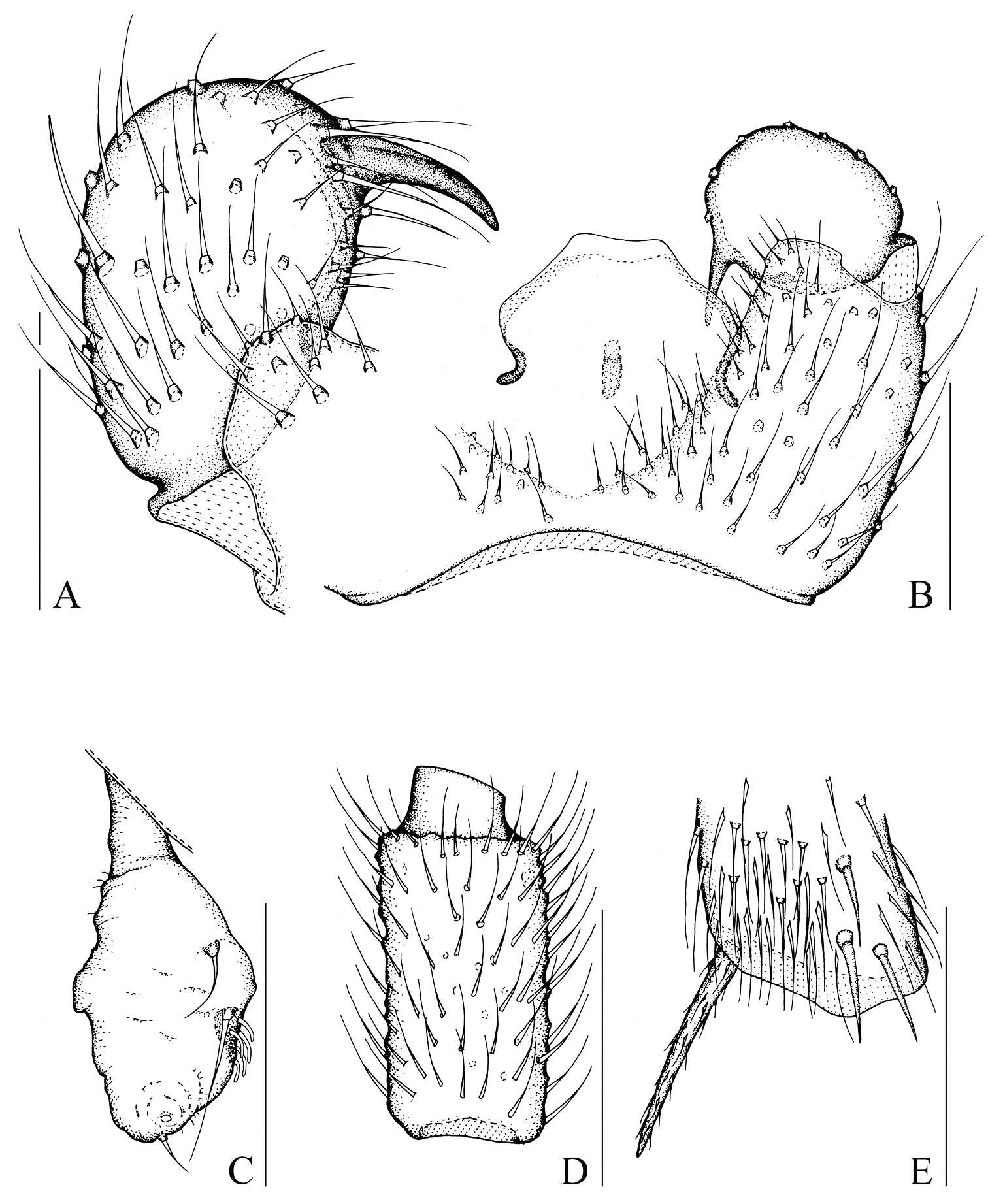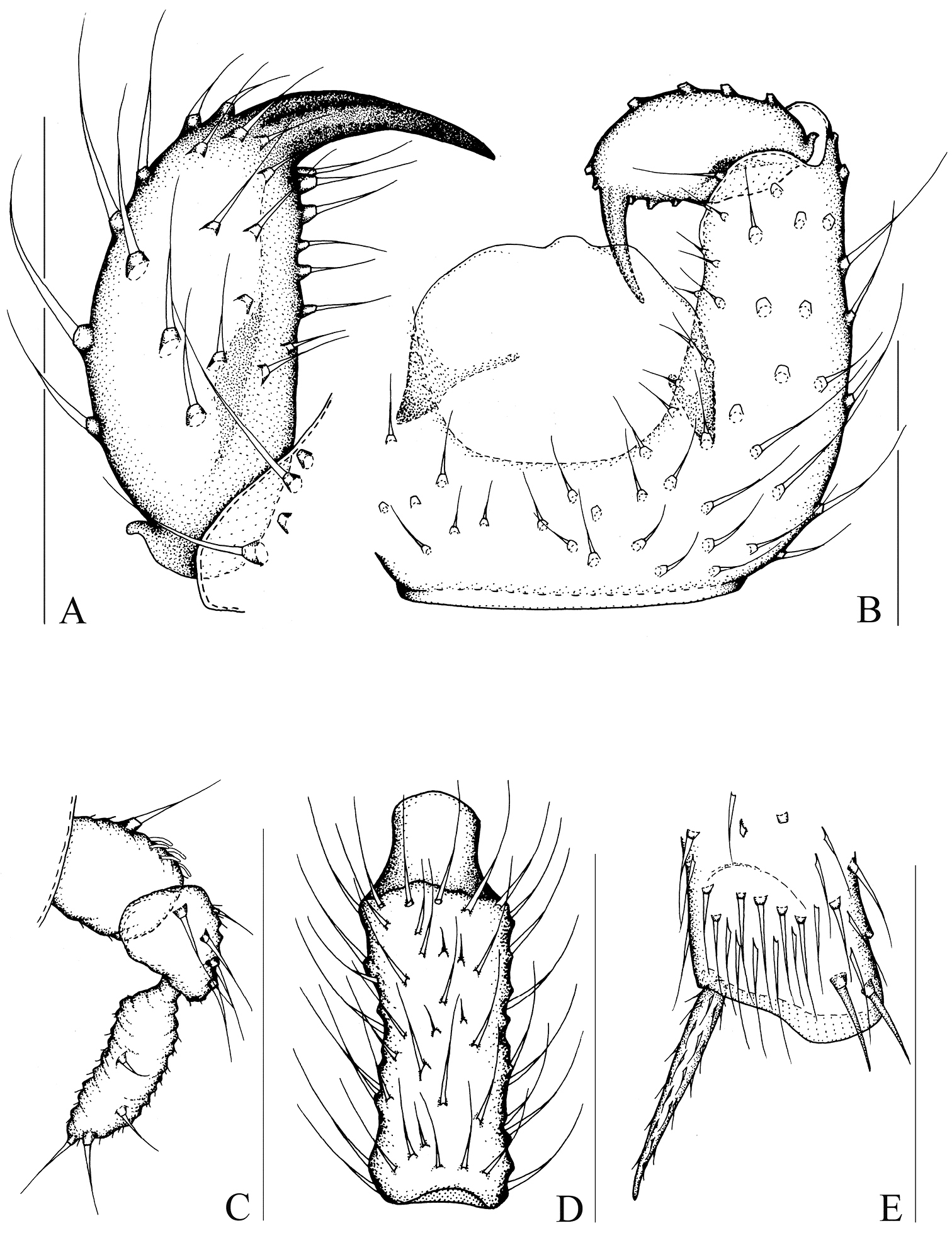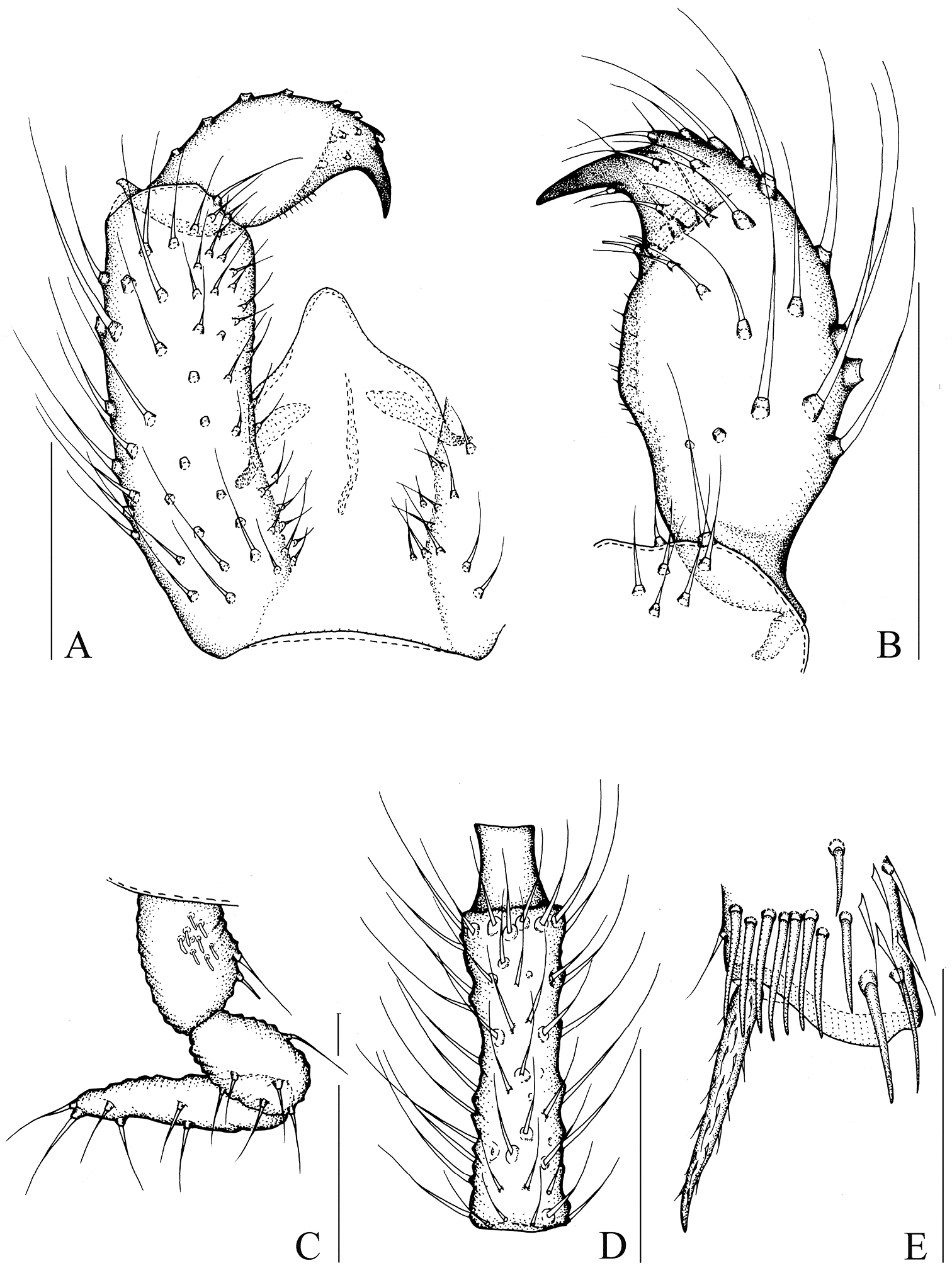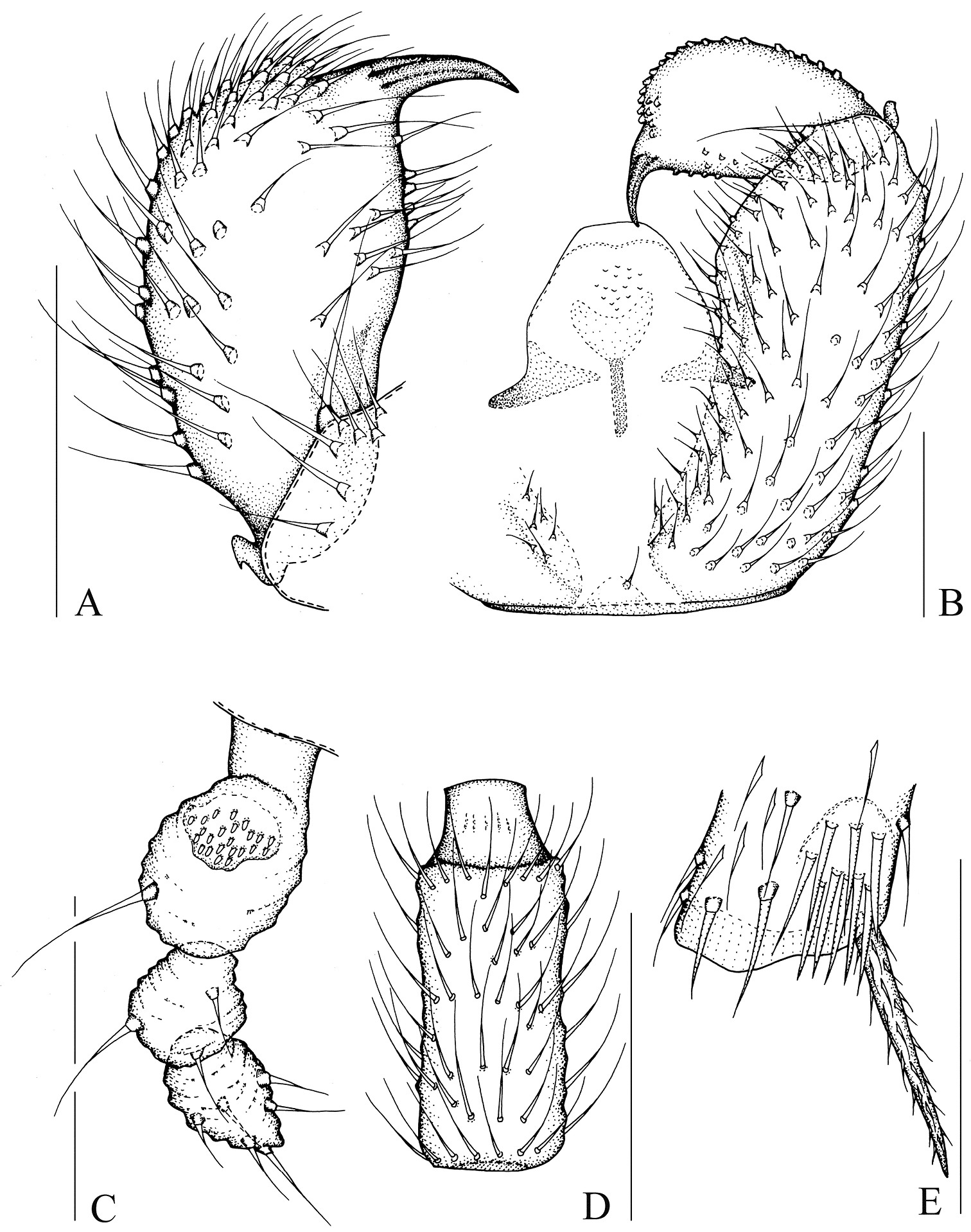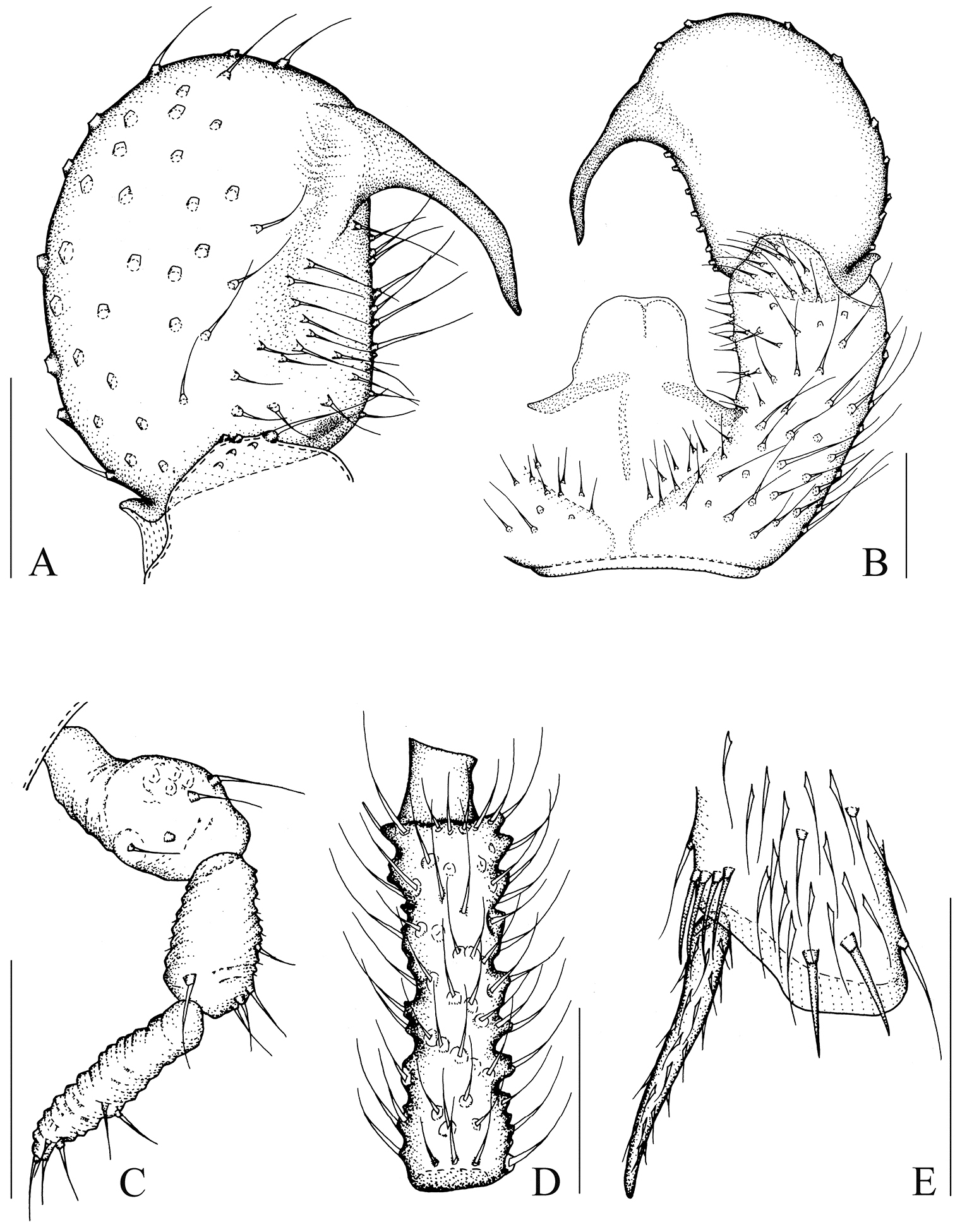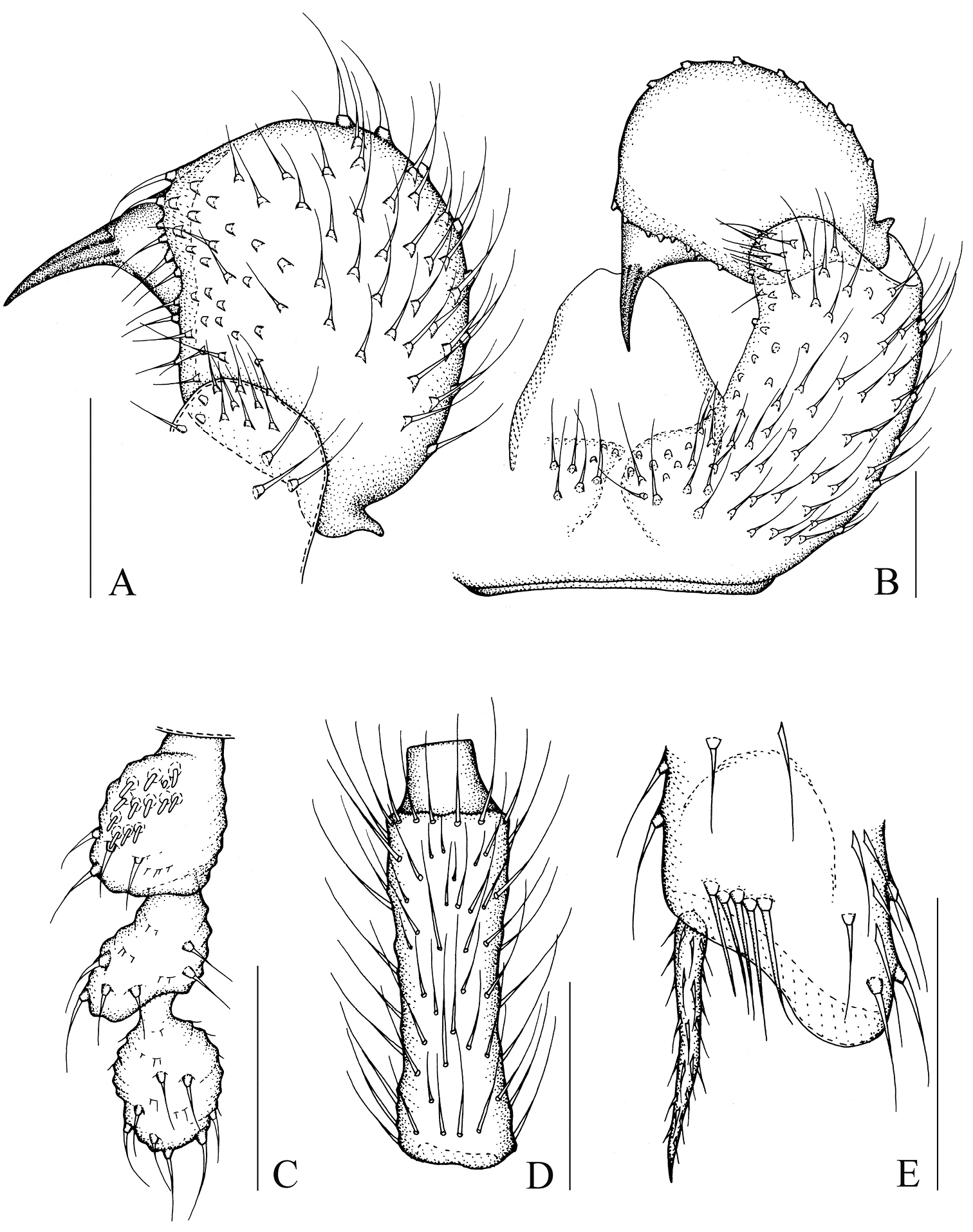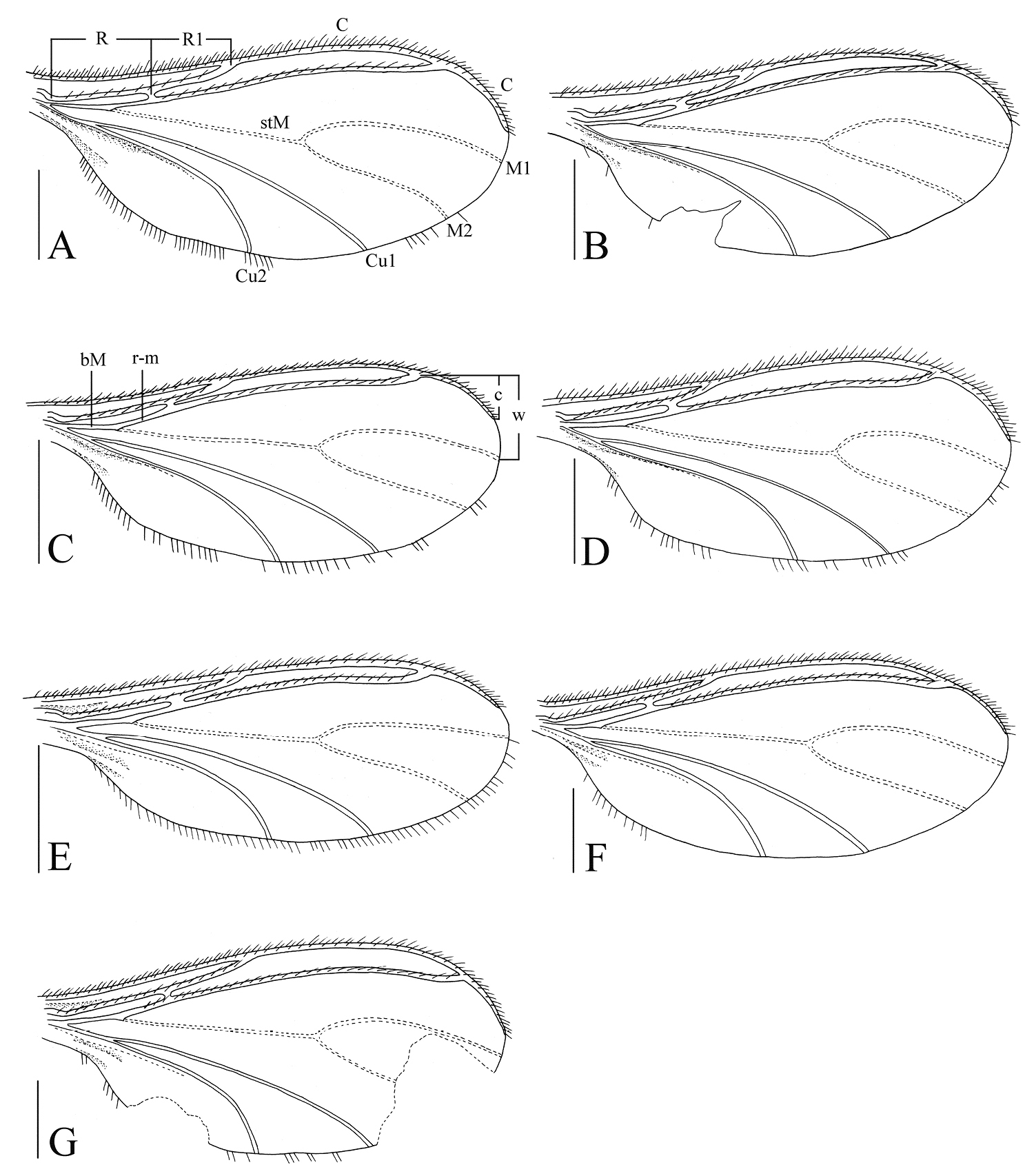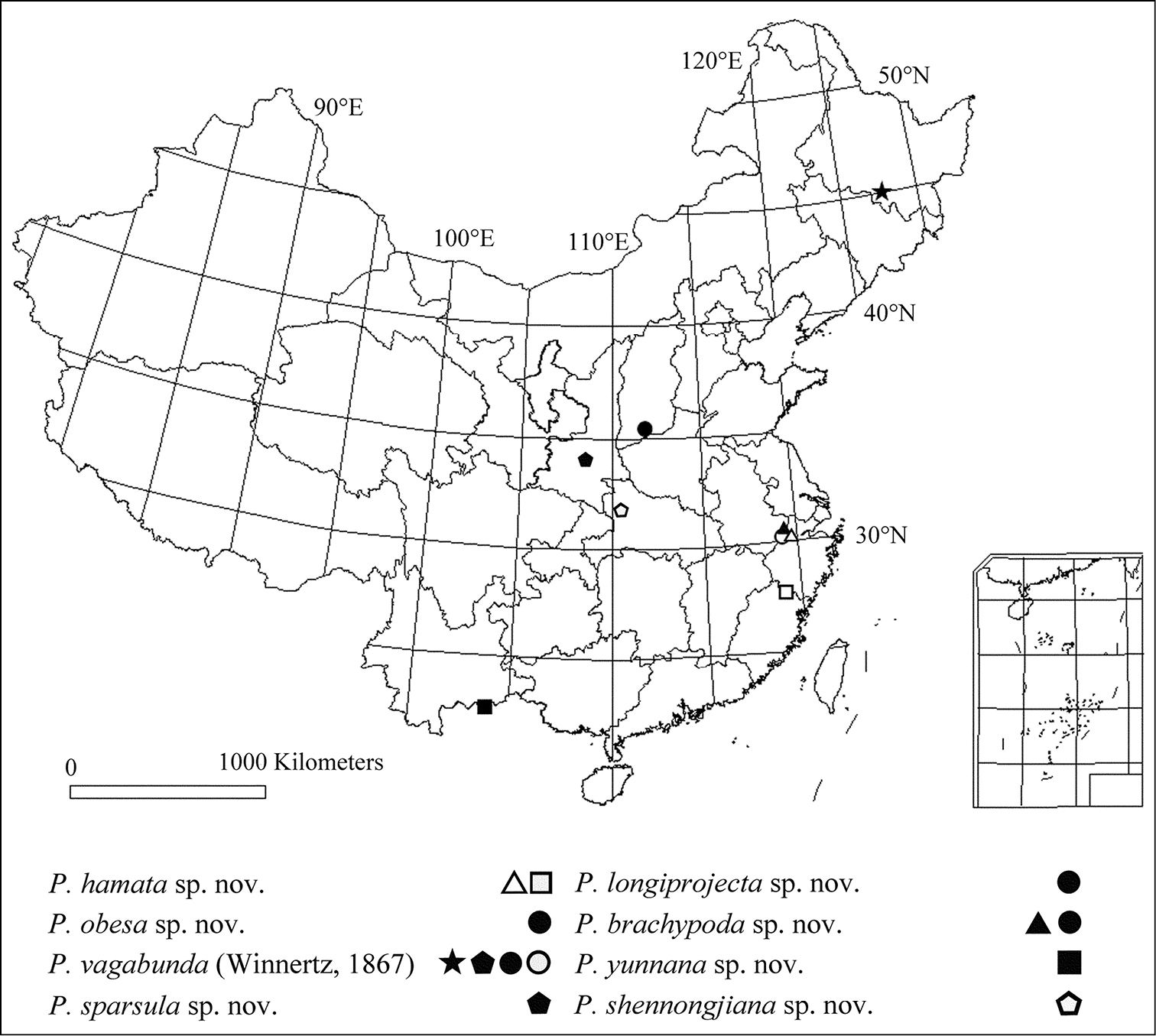






Citation: Shi K, Huang J, Zhang S, Wu H (2014) Taxonomy of the genus Peyerimhoffia Kieffer from Mainland China, with a description of seven new species (Diptera, Sciaridae). ZooKeys 382: 67–83. doi: 10.3897/zookeys.382.4948
The taxonomy of the genus Peyerimhoffia Kieffer in China was studied. Eight species were recognized, including seven new species that are herein described and illustrated: P. hamata sp. n., P. obesa sp. n., P. sparsula sp. n., P. longiprojecta sp. n., P. brachypodua sp. n., P. yunnana sp. n., and P. shennongjiana sp. n. In addition, P. vagabunda (Winnertz, 1867) is reported for the first time from China. A key to these Chinese species is provided.
Diptera, Sciaridae, new species, new record, China
Peyerimhoffia Kieffer, 1903 was described as a monotypic genus (type species Peyerimhoffia brachyptera Kieffer, 1903 = Sciara vagabunda Winnertz, 1867).
We herein follow the redefined concept of Peyerimhoffia from
The concept of Peyerimhoffia sensu Vilkamaa & Hippa was crisized by
The genus has never been recorded from China. In this study, we taxonomically revise the genus based on specimens collected in recent years by Zhejiang A&F University, China. Detailed illustrations, differential diagnoses, distributional information of each species, and a key to the Chinese species are provided.
All specimens were collected by sweeping, malaise trapping, and yellow trapping and were preserved in 75% ethanol. All were mounted on microscope slides in xylol-based Canada balsam after clearing in xylol. The slides were made under a Nikon SMZ1500 stereo microscope. The specimens were observed, measured, and illustrated under a Leica DM2500 microscope. This study was based on males only because most species characteristics of Peyerimhoffia are based on the male morphology, whereas females are not generally identifiable to the species level. The terminology follows
| 1 | Maxillary palp 1-segmented (Figs 1C, 2C) | 2 |
| – | Maxillary palp 3-segmented (Figs 3C, 4C, 5C, 6C, 7C) | 4 |
| 2 | Hypopygium with a lobe-like projecting intercoxal area, tegmen slightly and smoothly curved and sclerotized (Fig. 1B) | Peyerimhoffia hamata sp. n. |
| – | Hypopygium without lobe-like projecting intercoxal area, tegmen strongly curved and sclerotized (Fig. 2B) | 3 |
| 3 | Gonostylus very tumid, broadest on apical part, apical tooth short (about half as long as width of gonostylus) (Fig. 2A) | Peyerimhoffia obesa sp. n. |
| – | Gonostylus slightly tumid, broadest on mesial part, apical tooth long (as long as width of gonostylus) | Peyerimhoffia vagabunda (Winnertz, 1867) |
| 4 | Gonostylus narrowed, without apical lobe except a tooth on its apex (Figs 3A, 4B) | 5 |
| – | Gonostylus inflated, with an distinct apical lobe bearing a tooth (Figs 5A, 6A, 7A) | 6 |
| 5 | Apical tooth long (as long as width of gonostylus), tegmen almost truncate on the apical margin with a weak process (Fig. 3A, B) | Peyerimhoffia sparsula sp. n. |
| – | Apical tooth short (about half as long as width of gonostylus), tegmen greatly projected in the middle of apical margin (Fig. 4A, B) | Peyerimhoffia longiprojecta sp. n. |
| 6 | Basal palpomere with a sensory pit and one seta, gonostylus relatively narrowed, with apex densely setose (Fig. 5A, C) | Peyerimhoffia brachypoda sp. n. |
| – | Basal palpomere without sensory pit and with four setae, gonostylus inflated, with apex sparsely setose or bare (Figs 6A, C, 7A, C) | 7 |
| 7 | Apex of the gonostylus sparsely setose, and its apical tooth light and not sclerotized, tegmen narrowed abruptly on the middle and almost equilateral in ventral view (Fig. 6A, B) | Peyerimhoffia yunnana sp. n. |
| – | Apex of the gonostylus bare, and its apical tooth dark and sclerotized, tegmen narrowed evenly and almost triangular in ventral view (Fig. 7A, B) | Peyerimhoffia shennongjiana sp. n. |
http://zoobank.org/84B856A9-D5D6-45CB-9125-2118E425E230
http://species-id.net/wiki/Peyerimhoffia_hamata
Figs 1, 8A, 9Holotype, male. CHINA. Zhejiang Province, Linan, Jincheng, Mt. Xijingshan, sweep-net, 29.IV.2011, Kai Shi [SM01563]. Paratype, ZHEJIANG. 1 male, Qingyuan, Mt. Baishanzu, Wanli-linchang, sweep-net, 24.VII.2012, Lu-Jing Yang [SM01732].
Head dark brown; antenna, thorax, abdomen, and hypopygium brown; palp pale brown; legs pale yellowish-brown; wings fumose. Head (Fig. 1C, D). Eye bridge with 3 rows of facets. Prefrons with 4 setae. Clypeus non-setose. Maxillary palp 1-segmented, with 6 setae. Length/width of fourth flagellomere: 2.07–2.16. Thorax. Anterior pronotum with 3 setae, episternum 1 with 3 setae. Wings (Fig. 8A). Wing length 1.88–2.21 mm, width/length: 0.38–0.41. c/w: 0.61–0.73. R1/R: 0.68–0.90. M, Cu, stM, and r-m non-setose. Legs (Fig. 1E). Front tibia with non-bordered prolateral patch of modified setae. Length of spur/width of foretibia 1.18–1.23. Length of femur/length of metatarsus: foreleg 1.24–1.38. Length of metatarsus/length of tibia: foreleg 0.49–0.56, hind leg 0.44–0.49. Length of hind tibia/length of thorax 1.30–1.42. Hypopygium (Fig. 1A, B). Sternite 10 with one seta on each half.
Peyerimhoffia hamata Shi & Huang, sp. n., male, holotype. A Part of hypopygium, ventral view B Right gonostylus, ventral view C Palp, lateral view D Fourth flagellomere, lateral view E Apex of foretibia, prolateral view. Scale, 0.10 mm.
China, Zhejiang (Fig. 9).
Based on the form of the gonostylus, the new species is similar to Peyerimhoffia vagabunda (Winnertz, 1867). However, the new species can be distinguished in having an irregularly shaped palp (Fig. 1C), the gonostylus distinctly and mesially constricted on dorsal side, the tegmen slightly and smoothly curved, and a lobe-like projecting intercoxal area on the hypopygium. In contrast, Peyerimhoffia vagabunda has a regularly shaped palp, the gonostylus is evenly rounded on the dorsal side, the tegmen is strongly curved, and no lobe-like projecting intercoxal area occurs on the hypopygium.
This species is named after its hook-like gonostylus (Latin adjective hamatus = hooked).
http://zoobank.org/FD68BA82-6A0C-4B21-8516-C7B9DFE8BA27
http://species-id.net/wiki/Peyerimhoffia_obesa
Figs 2, 8B, 9Holotype, male. CHINA. Shanxi Province, Qinshui, Xiachuancun, Fuyuhe, sweep-net, 26.VII.2012, Kai Shi [SM01795].
Head dark brown; antenna and thorax brown; palp, abdomen, and hypopygium pale brown; legs yellowish-brown; wings fumose. Head (Fig. 2C, D). Eye bridge with 3 rows of facets. Prefrons with 3 setae. Clypeus non-setose. Maxillary palp 1-segmented, with 4 setae. Length/width of fourth flagellomere: 1.92. Thorax. Anterior pronotum with 6 setae, episternum 1 with 3 setae. Wings (Fig. 8B). Wing length 1.81 mm, width/length: 0.39. c/w: 0.73. R1/R: 0.70. M, Cu, stM, and r-m non-setose. Legs (Fig. 2E). Front tibia with a non-bordered prolateral patch of modified setae. Length of spur/width of foretibia 1.15. Length of femur/length of metatarsus: foreleg 1.29. Length of metatarsus/length of tibia: foreleg 0.51, hind leg 0.46. Length of hind tibia/length of thorax 1.32. Hypopygium (Fig. 2A, B). Sternite 10 with one seta on each half.
Peyerimhoffia obesa Shi & Huang, sp. n., male, holotype. A Left gonostylus, ventral view B Part of hypopygium, ventral view C Palp, lateral view D Fourth flagellomere, lateral view E Apex of foretibia, prolateral view. Scale, 0.10 mm.
China, Shanxi (Fig. 9).
Based on the form of the gonostylus, the new species is similar to Peyerimhoffia alpina (
This species is named after its globally inflated gonostylus (Latin adjective obesus = obese).
http://species-id.net/wiki/Peyerimhoffia_vagabunda
CHINA. HEILONGJIANG. 1 male, Haerbin, Shangzhi, Maoershan Nature Park, sweep-net, 26.VII.2008, Su-Jiong Zhang [SM00193]. SHAANXI. 1 male, Huxian, Laoyu, Baliping Zhuque Nature Park, sweep-net, 13.VII.2012, Junhao Huang [SM01656]. SHANXI. Qinshui: 2 males, Xiachuancun, Putonggou, yellow trap, 24.VII.2012, Kai Shi [SM017760–1777]; 1 male, Xiachuancun, Zhuweigou, sweep-net, 23.VII.2012, Kai Shi [SM01738]; 1 male, Xiachuancun, Zhuweigou, sweep-net, 25.VII.2012, Kai Shi [SM01770]; 1 male, Dahecun, Nanshenyu, sweep-net, 28.VII.2012, Kai Shi [SM01780]. ZHEJIANG. 1 male, Linan, Mt. Qingliangfeng, Qianqingtang, malaise trap, 15.V.2012 [SM01719].
The species is characterized by the 1-segmented palp, the gonostylus evenly narrowed toward the apex, the apical tooth as long as the width of the gonostylus, and the tegmen very strongly curved and sclerotized.
China (Heilongjiang, Shaanxi, Shanxi, Zhejiang – new record) (Fig. 6); Finland, Sweden, Italy, Russia (Primorsky Kray).
This species is new to China. The Chinese specimens examined show no obvious differences.
http://zoobank.org/41E8EFCF-E77D-4802-828B-127614361356
http://species-id.net/wiki/Peyerimhoffia_sparsula
Figs 3, 8C, 9Holotype, male. CHINA. Shaanxi Province, Huxian, Laoyu, Baliping Zhuque Nature Park, sweep-net, 12.VII.2012, Kai Shi [SM01712].
Head dark brown; antenna, thorax, abdomen, and hypopygium brown; palp pale brown; legs yellowish-brown; wings fumose. Head (Figs 3C, D). Eye bridge with 3 rows of facets. Prefrons with 5 setae. Clypeus with 1 seta. Maxillary palp 3-segmented, segment 1 with one seta. Length/width of fourth flagellomere: 2.30. Thorax. Anterior pronotum with 2 setae, episternum 1 with 4 setae. Wings (Fig. 8C). Wing length 1.46 mm, width/length: 0.39. c/w: 0.54. R1/R: 0.61. M, Cu, stM, and r-m non-setose. Legs (Fig. 3E). Front tibia with proximally bordered prolateral patch of modified setae. Length of spur/width of foretibia 1.28. Length of femur/length of metatarsus: foreleg 1.48. Length of metatarsus/length of tibia: foreleg 0.52, hind leg 0.50. Length of hind tibia/length of thorax 1.29. Hypopygium (Fig. 3A, B). Sternite 10 with one seta on each half.
Peyerimhoffia sparsula Shi & Huang, sp. n., male, holotype. A Left gonostylus, ventral view B Part of hypopygium, ventral view C Palp, lateral view D Fourth flagellomere, lateral view E Apex of foretibia, prolateral view. Scale, 0.10 mm.
China, Shaanxi (Fig. 9).
Based on the form of the gonostylus, the new species is similar to Peyerimhoffia ultima Vilkamaa & Hippa, 1998. However, the new species can be distinguished by the front tibia with a proximally bordered prolateral patch of modified setae, the gonostylus with few short subapical setae, and the tegmen sub-truncate apically. In contrast, Peyerimhoffia ultima has an indistinct row of setae on the front tibia, a gonostylus with numerous long subapical setae, and a tegmen moderately curved apically.
This species is named after its sparse setosity on the gonocoxite (Latin adjective sparsulus = sparse).
http://zoobank.org/82672F3F-A9D4-4D7E-BCE8-9802B01E9CBF
http://species-id.net/wiki/Peyerimhoffia_longiprojecta
Figs 4, 8D, 9Holotype, male. CHINA. Shanxi Province, Qinshui, Xiachuancun, Putonggou, sweep-net, 24.VII.2012, Kai Shi [SM01737]. Paratype, SHANXI. 1 male, the same data as holotype [SM01736].
Head dark brown; antenna, thorax, and abdomen brown; palp and hypopygium pale brown; legs yellowish-brown; wings fumose. Head (Fig. 4C, D). Eye bridge with 3 rows of facets. Prefrons with 7–8 setae. Clypeus non-setose. Maxillary palp 3-segmented, segment 1 with 2 setae. Length/width of fourth flagellomere: 3.86–4.07. Thorax. Anterior pronotum with 2 setae, episternum 1 with 3 setae. Wings (Fig. 8D). Wing length 1.80 mm, width/length: 0.39. c/w: 0.81. R1/R: 0.43. M, Cu, stM, and r-m non-setose. Legs (Fig. 4E). Front tibia with an indistinct row of seven spinose setae. Length of spur/width of foretibia 1.27–1.39. Length of femur/length of metatarsus: foreleg 1.34–1.43. Length of metatarsus/length of tibia: foreleg 0.46–0.50, hind leg 0.46–0.47. Length of hind tibia/length of thorax 1.40–1.35. Hypopygium (Fig. 4A, B). Sternite 10 with one seta on each half.
Peyerimhoffia longiprojecta Shi & Huang, sp. n., male, holotype. A Part of hypopygium, ventral view B Right gonostylus, ventral view C Palp, lateral view D Fourth flagellomere, lateral view E Apex of foretibia, prolateral view. Scale, 0.10 mm.
China, Shanxi (Fig. 9).
This species is unique within the genus in having its tegmen greatly projected in the middle of the apical margin. Based on the form of the gonostylus, it is similar to Peyerimhoffia menzeli Vilkamaa & Hippa, 2005, but differs in having a very slender fourth flagellomere that is about four times longer than its width and a tegmen that is strongly projected apically. In contrast, in Peyerimhoffia menzeli, the fourth flagellomere is about twice longer than its width and the tegmen is truncate apically.
This species is named after the great middle projection of the apical tegmen (Latin adjective longiprojecta = long projection).
http://zoobank.org/E39D802B-D633-44EE-A527-83B4E39B6828
http://species-id.net/wiki/Peyerimhoffia_brachypoda
Figs 5, 8E, 9Holotype, male. CHINA. Zhejiang province, Anji, Mt. Longwangshan, sweep-net, 31.III.2012, Kai Shi [SM01588]. Paratype, SHANXI. 1 male, Qinshui, Dongchuancun, Dongxia, sweep-net, 25.VII.2012, Kai Shi [SM01791].
Head dark brown; antenna, thorax, abdomen and hypopygium brown; palp pale brown; legs yellowish-brown; wings fumose. Head (Fig. 5C, D). Eye bridge with 2 rows of facets. Prefrons with 4 setae. Clypeus with 2 setae. Maxillary palp 3-segmented, segment 1 with 1–2 setae. Length/width of 4th flagellomere: 2.36–2.74. Thorax. Anterior pronotum with 2 setae, episternum 1 with 4–5 setae. Wings (Fig. 8E). Wing length 1.34–1.46 mm, width/length: 0.41–0.44. c/w: 0.52–0.55. R1/R: 0.51–0.53. M, Cu, stM and r-m nonsetose. Legs (Fig. 5E). Front tibia with bordered prolateral patch of few strong modified setae. Length of spur/width of foretibia 1.13–1.19. Length of femur/length of metatarsus: foreleg 1.37–1.75. Length of metatarsus/length of tibia: foreleg 0.51–0.54, hind leg 0.45–0.49. Length of hind tibia/length of thorax 1.47–1.50. Hypopygium (Fig. 5A, B). Sternite 10 with one seta on each half.
Peyerimhoffia brachypoda Shi & Huang, sp. n., male, holotype. A Left gonostylus, ventral view B Part of hypopygium, ventral view C Palp, lateral view D Fourth flagellomere, lateral view E Apex of foretibia, prolateral view. Scale, 0.10 mm.
China (Shanxi, Zhejiang, Fig. 9).
The new species is similar to Peyerimhoffia infera Vilkamaa & Hippa, 2005 in the shape of the gonostylus. However, the new species can be distinguished by the three-segmented maxillary palp, the gonostylus having much inflated apex and short subapical setae (two-segmented maxillary palp, the gonostylus slightly inflated at apex and bearing long subapical setae in Peyerimhoffia infera).
This species is named in reference to its short apical lobe, from theGreek adjective brachypodus, meaning short base.
http://zoobank.org/7FEE26A1-7F74-462F-8C00-6E045E6DC32E
http://species-id.net/wiki/Peyerimhoffia_yunnana
Figs 6, 8F, 9Holotype, male. CHINA. Yunnan province, Honghe, Lvcun, Mt. Huanglianshan, Yakou, 1950 m, sweep-net, 8.V.2011, Yan Li [SM01589].
Head dark brown; antenna, thorax, abdomen and hypopygium brown; palp pale brown; legs yellowish-brown; wings fumose. Head (Fig. 6C, D). Eye bridge with 3 rows of facets. Prefrons with 11 setae. Clypeus with 1 seta. Maxillary palp 3-segmented, segment 1 with 4 setae. Length/width of 4th flagellomere: 4.37. Thorax. Anterior pronotum with 6 setae, episternum 1 with 4 setae. Wings (Fig. 8F). Wing length 2.06 mm, width/length: 0.44. c/w: 0.59. R1/R: 0.67. M, Cu, stM and r-m nonsetose. Legs (Fig. 6E). Front tibia with non-bordered prolateral patch of 4 modified setae in low. Length of spur/width of foretibia 1.38. Length of femur/length of metatarsus: foreleg 1.34. Length of metatarsus/length of tibia: foreleg 0.54, hind leg 0.49. Length of hind tibia/length of thorax 1.68. Hypopygium (Fig. 6A, B). Sternite 10 with one seta on each half.
Peyerimhoffia yunnana Shi & Huang, sp. n., male, holotype. A Left gonostylus, ventral view B Part of hypopygium, ventral view C Palp, lateral view D Fourth flagellomere, lateral view E Apex of foretibia, prolateral view. Scale, 0.10 mm.
China (Yunnan, Fig. 9).
This species is unique in having the light-colored gonostylar apical tooth, which is not scleritised.
This species is named after its type locality, Yunnan province, China.
http://zoobank.org/8F2367D5-2651-4AC4-A181-983F09875DCB
http://species-id.net/wiki/Peyerimhoffia_shennongjiana
Figs 7, 8G, 9Holotype, male. CHINA. Hubei province, Shennongjia, Dalongtan, sweep-net, 20.V.2012, Kai Shi [SM01662].
Head dark brown; palp, antenna, thorax, abdomen and hypopygium brown; legs yellowish-brown; wings fumose. Head (Fig. 7C, D). Eye bridge with 3 rows of facets. Prefrons with 26 setae. Clypeus with 1 seta. Maxillary palp 3-segmented, segment 1 with 4 setae. Length/width of 4th flagellomere: 2.83. Thorax. Anterior pronotum with 2 setae, episternum 1 with 4 setae. Wings (Fig. 8G). Wing length 2.25 mm, width/length: 0.46. c/w: 0.79. R1/R: 0.88. M, Cu and stM nonsetose. r-m with 4 setae. Legs (Fig. 7E). Front tibia with bordered prolateral patch of 5 modified setae. Length of spur/width of foretibia 1.06. Length of femur/length of metatarsus: foreleg 1.69. Length of metatarsus/length of tibia: foreleg 0.48, hind leg 0.50. Length of hind tibia/length of thorax 1.45. Hypopygium (Fig. 7A, B). Sternite 10 with one seta on each half.
Peyerimhoffia shennongjiana Shi & Huang, sp. n., male, holotype. A Right gonostylus, ventral view B Part of hypopygium, ventral view C Palp, lateral view D Fourth flagellomere, lateral view E Apex of foretibia, prolateral view. Scale, 0.10 mm.
Wings, dorsal view. A Peyerimhoffia hamata sp. n. (holotype) B Peyerimhoffia obesa sp. n. (holotype) C Peyerimhoffia sparsula sp. n. (holotype) D Peyerimhoffia longiprojecta sp. n. (holotype) E Peyerimhoffia brachypoda sp. n. (holotype) F Peyerimhoffia yunnana sp. n. (holotype) G Peyerimhoffia shennongjiana sp. n. (holotype). Scale, 0.50 mm.
China (Hubei, Fig. 9).
Geographical distribution of Peyerimhoffia from China.
This species can be readily recognized by having two unique characteristics: the gonostylar apex bare, and a dorsally located lobe on its inflated gonostylus.
This species is named after its type locality, Shennongjia at Hubei province, China.
We thank Dr. Heikki Hippa (Swedish Museum of Natural History, Stockholm) and Dr. Pekka Vilkamaa (Finnish Museum of Natural History, Helsinki) for their attentively examination of all the materials in this study and critical review of the manuscript. Thanks are also given to Dr. Lyudmila Komarova (The Shukshin Altai State Academy of Education, Biysk) for her generous help and encouragement. This study was supported by the National Natural Science Foundation of China (NSFC, Grant No. 31372244).

